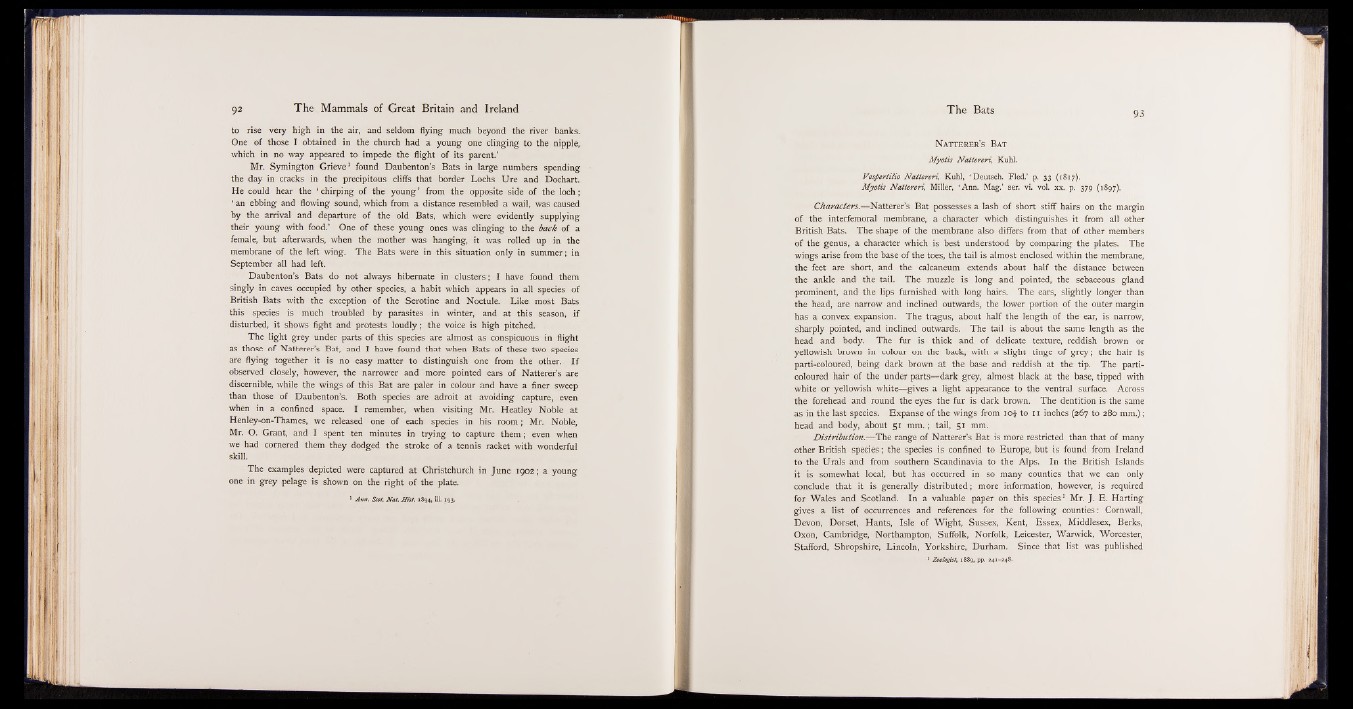
to rise very high in the air, and seldom flying much beyond the river banks.
One of those I obtained in the church had a young one clinging to the nipple,
which in no way appeared to impede the flight of its parent.’
Mr. Symington Grieve1 found Daubenton’s Bats in large numbers spending
the day in cracks in the precipitous cliffs that border Lochs Ure and Dochart.
He could hear the ‘ chirping of the young ’ from the opposite side of the loch;
‘ an ebbing and flowing sound, which from a distance resembled a wail, was caused
by the arrival and departure of the old Bats, which were evidently supplying
their young with food.’ One of these young ones was clinging to the back of a
female, but afterwards, when the mother was hanging, it was rolled up in the
membrane of the left wing. The Bats were in this situation only in summer; in
September all had left.
Daubenton’s Bats do not always hibernate in clusters; I have found them
singly in caves occupied by other species, a habit which appears in all species of
British Bats with the exception of the Serotine and Noctule. Like, most Bats
this species is much troubled by parasites in winter, and at this season, if
disturbed, it shows fight and protests loudly; the voice is high pitched.
The light grey under parts of this species are almost as conspicuous in flight
as those of Natterer’s Bat, and I have found that when Bats of these two species
are flying together it is no easy matter to distinguish one from the other. I f
observed closely, however, the narrower and more pointed ears of Natterer’s are
discernible, while the wings of this Bat are paler in colour and have a finer sweep
than those of Daubenton’s. Both species are adroit at avoiding capture, even
when in a confined space. I remember, when visiting Mr. Heatley Noble at
Henley-on-Thames, we released one of each species in his room; Mr. Noble,
Mr. O. Grant, and I spent ten minutes in trying to capture them; even when
we had cornered them they dodged the stroke of a tennis racket with wonderful
skill.
The examples depicted were captured at Christchurch in June 1902; a young
one in grey pelage is shown on the right of the plate.
1 Ann. Scot. Nat. H ist. 1894, iii. 193.
N a t t e r e r ’s B a t
Myotis N attereri, Kuhl.
Vespertilio Nattereri, Kuhl, ‘ Deutsch. Fled.’ p. 33 (1817).
Myotis Nattereri, Miller, ‘ Ann. Mag.’ ser. vi. vol. xx. p. 379 (1897).
Characters.— Natterer’s Bat possesses a lash of short stiff hairs on the margin
of the interfemoral membrane, a character which distinguishes it from all other
British Bats. The shape of the membrane also differs from that of other members
of the genus, a character which is best understood by comparing the plates. The
wings arise from the base of the toes, the tail is almost enclosed within the membrane,
the feet are short, and the calcaneum extends about half the distance between
the ankle and the tail. The muzzle is long and pointed, the sebaceous gland
prominent, and the lips furnished with long hairs. The ears, slightly longer than
the head, are narrow and inclined outwards, the lower portion of the outer margin
has a convex expansion. The tragus, about half the length of the ear, is narrow,
sharply pointed, and inclined outwards. The tail is about the same length as the
head and body. The fur is thick and of delicate texture, reddish brown or
yellowish brown in colour on the back, with a slight tinge of grey; the hair is
parti-coloured, being dark brown at the base and reddish at the tip. The particoloured
hair of the under parts— dark grey, almost black at the base, tipped with
white or yellowish white—gives a light appearance to the ventral surface. Across
the forehead and round the eyes the fur is dark brown. The dentition is the same
as in the last species. Expanse of the wings from io£ to 11 inches (267 to 280 mm.);
head and body, about 51 mm.; tail, 51 mm.
Distribution.— The range of Natterer’s Bat is more restricted than that of many
other British species; the species is confined to Europe, but is found from Ireland
to the Urals and from southern Scandinavia to the Alps. In the British Islands
it is somewhat local, but has occurred in so many counties that we can only
conclude that it is generally distributed; more information, however, is required
for Wales and Scotland. In a valuable paper on this species1 Mr. J. E. Harting
gives a list of occurrences and references for the following counties: Cornwall,
Devon, Dorset, Hants, Isle of Wight, Sussex, Kent, Essex, Middlesex, Berks,
Oxon, Cambridge, Northampton, Suffolk, Norfolk, Leicester, Warwick, Worcester,
Stafford, Shropshire, Lincoln, Yorkshire, Durham. Since that list was published
1 Zoologist, 1889, pp. 241-248.